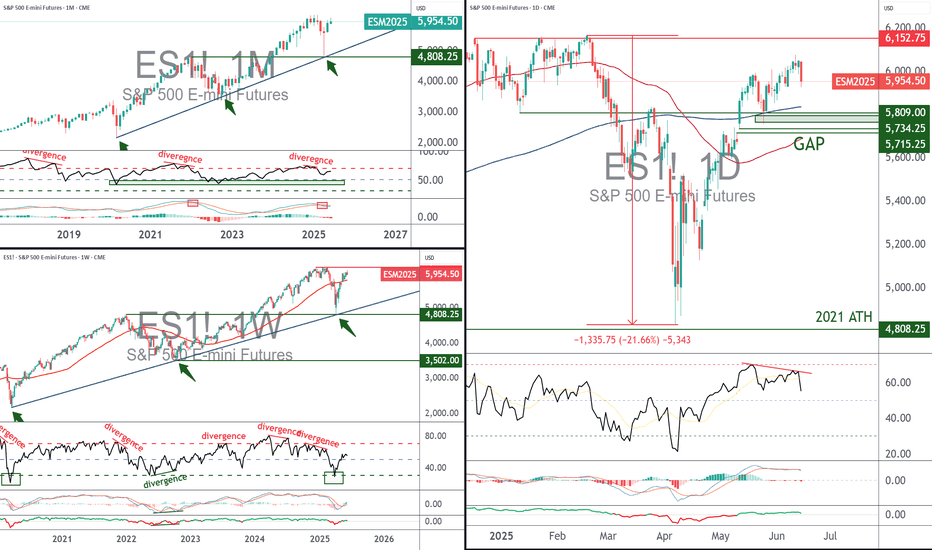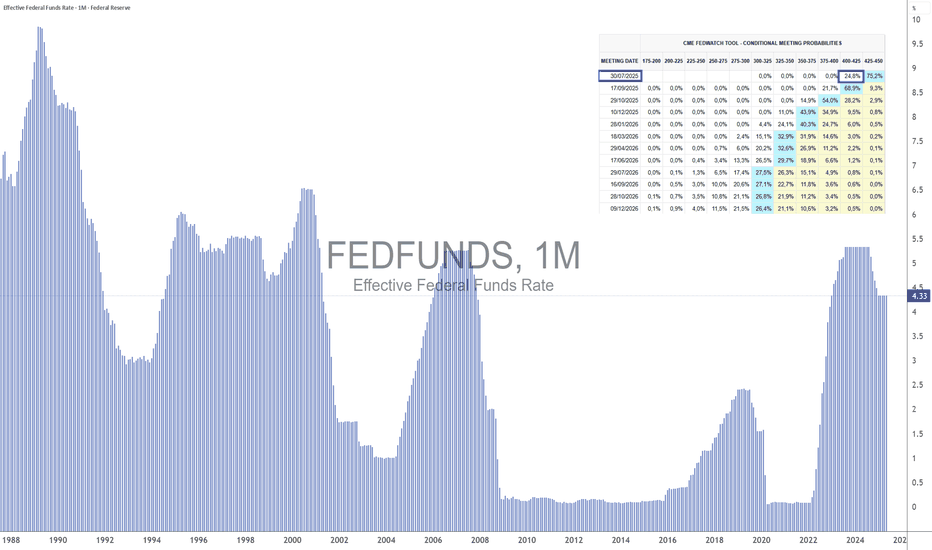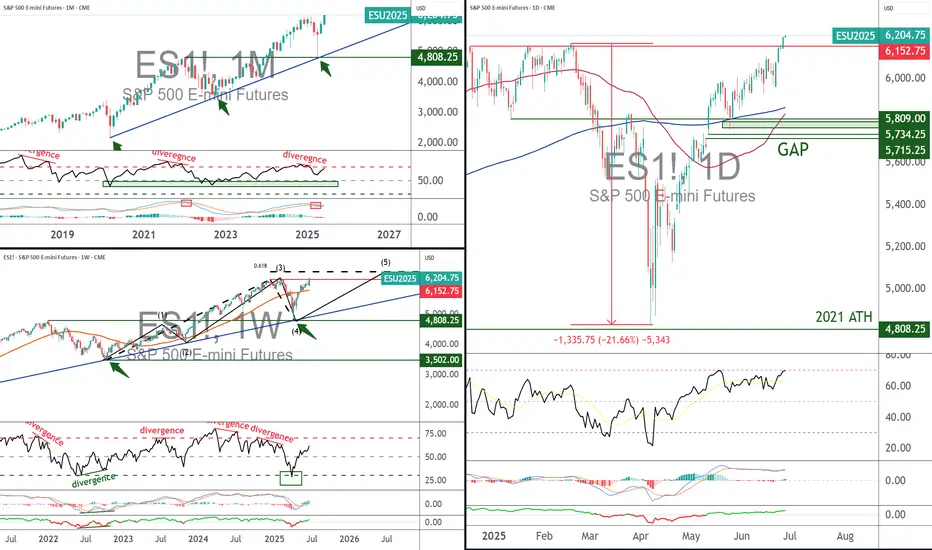Technical objective achieved! The S&P 500 index has reached its all-time high, offering a bullish V-shaped recovery since the bearish shock of early April against the backdrop of the trade war between the USA and its main trading partners.
In our previous TradingView analysis, we highlighted numerous favorable technical signals since mid-April in favor of this rally towards the all-time record, including an analysis of the chart battlefield for the S&P 500 index at the beginning of June, which you can reread by clicking on the image below. In general, don't hesitate to follow our Swissquote account for regular updates on stock market indices and all other asset classes (bitcoin, forex, commodities, etc.).

The short-term question is whether the S&P 500 index is in a position to break through its all-time high (ATH) in the immediate future, or whether it needs to enter a consolidation phase first.
The answer to this question is both technical and fundamental.
1) From a technical point of view, here are the conditions that would enable the S&P 500 to surpass its all-time record (even if it were to enter a short-term bearish consolidation first)
The market may need to take a breather in the short term after the strong upward rally of the last two months. But for the medium/long term, the underlying trend remains bullish above support at 5800 points and above the 200-day moving average. On the long time horizon, the theoretical target for wave 5 (Elliott waves) lies at 6500 points.

In order for the S&P 500 to be in a position to break through its all-time record, it is imperative that stocks in the most important sectors in terms of weighting are bullish. The S&P 500 can only go higher if the technology, financials and consumer discretionary sectors contribute.

The study of US retail trader sentiment provides a contrarian approach to the financial markets, and it bodes well that doubt and pessimism remain dominant among retail investors. Bear in mind that market tops are built on euphoria, not pessimism.

Finally, in terms of quantitative analysis, the overbought zone is still a long way from the current price level, so it's conceivable that the S&P 500 index could be in a position to surpass its all-time record in the course of July, even if a consolidation phase were to develop in the short term.

2) In terms of fundamentals, two factors seem to me to be essential for the S&P 500 index to be in a position to make further progress
Firstly, the US equity market will not move higher until there is confirmation that the Fed will resume cutting the federal funds rate. On this subject, this week we offered you a full fundamental analysis, which you can read below. The market needs the FED's pivot on either July 30 or September 17. In terms of valuation, the S&P 500 is expensive again, so rate cuts are needed to justify further upside.

With the rebound in share prices over the past 2 months, S&P 500 valuation is indeed back in the high zone, so we'll need sharply higher prospective earnings to justify a possible new all-time high in the coming months.

DISCLAIMER:
This content is intended for individuals who are familiar with financial markets and instruments and is for information purposes only. The presented idea (including market commentary, market data and observations) is not a work product of any research department of Swissquote or its affiliates. This material is intended to highlight market action and does not constitute investment, legal or tax advice. If you are a retail investor or lack experience in trading complex financial products, it is advisable to seek professional advice from licensed advisor before making any financial decisions.
This content is not intended to manipulate the market or encourage any specific financial behavior.
Swissquote makes no representation or warranty as to the quality, completeness, accuracy, comprehensiveness or non-infringement of such content. The views expressed are those of the consultant and are provided for educational purposes only. Any information provided relating to a product or market should not be construed as recommending an investment strategy or transaction. Past performance is not a guarantee of future results.
Swissquote and its employees and representatives shall in no event be held liable for any damages or losses arising directly or indirectly from decisions made on the basis of this content.
The use of any third-party brands or trademarks is for information only and does not imply endorsement by Swissquote, or that the trademark owner has authorised Swissquote to promote its products or services.
Swissquote is the marketing brand for the activities of Swissquote Bank Ltd (Switzerland) regulated by FINMA, Swissquote Capital Markets Limited regulated by CySEC (Cyprus), Swissquote Bank Europe SA (Luxembourg) regulated by the CSSF, Swissquote Ltd (UK) regulated by the FCA, Swissquote Financial Services (Malta) Ltd regulated by the Malta Financial Services Authority, Swissquote MEA Ltd. (UAE) regulated by the Dubai Financial Services Authority, Swissquote Pte Ltd (Singapore) regulated by the Monetary Authority of Singapore, Swissquote Asia Limited (Hong Kong) licensed by the Hong Kong Securities and Futures Commission (SFC) and Swissquote South Africa (Pty) Ltd supervised by the FSCA.
Products and services of Swissquote are only intended for those permitted to receive them under local law.
All investments carry a degree of risk. The risk of loss in trading or holding financial instruments can be substantial. The value of financial instruments, including but not limited to stocks, bonds, cryptocurrencies, and other assets, can fluctuate both upwards and downwards. There is a significant risk of financial loss when buying, selling, holding, staking, or investing in these instruments. SQBE makes no recommendations regarding any specific investment, transaction, or the use of any particular investment strategy.
CFDs are complex instruments and come with a high risk of losing money rapidly due to leverage. The vast majority of retail client accounts suffer capital losses when trading in CFDs. You should consider whether you understand how CFDs work and whether you can afford to take the high risk of losing your money.
Digital Assets are unregulated in most countries and consumer protection rules may not apply. As highly volatile speculative investments, Digital Assets are not suitable for investors without a high-risk tolerance. Make sure you understand each Digital Asset before you trade.
Cryptocurrencies are not considered legal tender in some jurisdictions and are subject to regulatory uncertainties.
The use of Internet-based systems can involve high risks, including, but not limited to, fraud, cyber-attacks, network and communication failures, as well as identity theft and phishing attacks related to crypto-assets.
In our previous TradingView analysis, we highlighted numerous favorable technical signals since mid-April in favor of this rally towards the all-time record, including an analysis of the chart battlefield for the S&P 500 index at the beginning of June, which you can reread by clicking on the image below. In general, don't hesitate to follow our Swissquote account for regular updates on stock market indices and all other asset classes (bitcoin, forex, commodities, etc.).

The short-term question is whether the S&P 500 index is in a position to break through its all-time high (ATH) in the immediate future, or whether it needs to enter a consolidation phase first.
The answer to this question is both technical and fundamental.
1) From a technical point of view, here are the conditions that would enable the S&P 500 to surpass its all-time record (even if it were to enter a short-term bearish consolidation first)
The market may need to take a breather in the short term after the strong upward rally of the last two months. But for the medium/long term, the underlying trend remains bullish above support at 5800 points and above the 200-day moving average. On the long time horizon, the theoretical target for wave 5 (Elliott waves) lies at 6500 points.
In order for the S&P 500 to be in a position to break through its all-time record, it is imperative that stocks in the most important sectors in terms of weighting are bullish. The S&P 500 can only go higher if the technology, financials and consumer discretionary sectors contribute.
The study of US retail trader sentiment provides a contrarian approach to the financial markets, and it bodes well that doubt and pessimism remain dominant among retail investors. Bear in mind that market tops are built on euphoria, not pessimism.
Finally, in terms of quantitative analysis, the overbought zone is still a long way from the current price level, so it's conceivable that the S&P 500 index could be in a position to surpass its all-time record in the course of July, even if a consolidation phase were to develop in the short term.
2) In terms of fundamentals, two factors seem to me to be essential for the S&P 500 index to be in a position to make further progress
Firstly, the US equity market will not move higher until there is confirmation that the Fed will resume cutting the federal funds rate. On this subject, this week we offered you a full fundamental analysis, which you can read below. The market needs the FED's pivot on either July 30 or September 17. In terms of valuation, the S&P 500 is expensive again, so rate cuts are needed to justify further upside.

With the rebound in share prices over the past 2 months, S&P 500 valuation is indeed back in the high zone, so we'll need sharply higher prospective earnings to justify a possible new all-time high in the coming months.
DISCLAIMER:
This content is intended for individuals who are familiar with financial markets and instruments and is for information purposes only. The presented idea (including market commentary, market data and observations) is not a work product of any research department of Swissquote or its affiliates. This material is intended to highlight market action and does not constitute investment, legal or tax advice. If you are a retail investor or lack experience in trading complex financial products, it is advisable to seek professional advice from licensed advisor before making any financial decisions.
This content is not intended to manipulate the market or encourage any specific financial behavior.
Swissquote makes no representation or warranty as to the quality, completeness, accuracy, comprehensiveness or non-infringement of such content. The views expressed are those of the consultant and are provided for educational purposes only. Any information provided relating to a product or market should not be construed as recommending an investment strategy or transaction. Past performance is not a guarantee of future results.
Swissquote and its employees and representatives shall in no event be held liable for any damages or losses arising directly or indirectly from decisions made on the basis of this content.
The use of any third-party brands or trademarks is for information only and does not imply endorsement by Swissquote, or that the trademark owner has authorised Swissquote to promote its products or services.
Swissquote is the marketing brand for the activities of Swissquote Bank Ltd (Switzerland) regulated by FINMA, Swissquote Capital Markets Limited regulated by CySEC (Cyprus), Swissquote Bank Europe SA (Luxembourg) regulated by the CSSF, Swissquote Ltd (UK) regulated by the FCA, Swissquote Financial Services (Malta) Ltd regulated by the Malta Financial Services Authority, Swissquote MEA Ltd. (UAE) regulated by the Dubai Financial Services Authority, Swissquote Pte Ltd (Singapore) regulated by the Monetary Authority of Singapore, Swissquote Asia Limited (Hong Kong) licensed by the Hong Kong Securities and Futures Commission (SFC) and Swissquote South Africa (Pty) Ltd supervised by the FSCA.
Products and services of Swissquote are only intended for those permitted to receive them under local law.
All investments carry a degree of risk. The risk of loss in trading or holding financial instruments can be substantial. The value of financial instruments, including but not limited to stocks, bonds, cryptocurrencies, and other assets, can fluctuate both upwards and downwards. There is a significant risk of financial loss when buying, selling, holding, staking, or investing in these instruments. SQBE makes no recommendations regarding any specific investment, transaction, or the use of any particular investment strategy.
CFDs are complex instruments and come with a high risk of losing money rapidly due to leverage. The vast majority of retail client accounts suffer capital losses when trading in CFDs. You should consider whether you understand how CFDs work and whether you can afford to take the high risk of losing your money.
Digital Assets are unregulated in most countries and consumer protection rules may not apply. As highly volatile speculative investments, Digital Assets are not suitable for investors without a high-risk tolerance. Make sure you understand each Digital Asset before you trade.
Cryptocurrencies are not considered legal tender in some jurisdictions and are subject to regulatory uncertainties.
The use of Internet-based systems can involve high risks, including, but not limited to, fraud, cyber-attacks, network and communication failures, as well as identity theft and phishing attacks related to crypto-assets.
This content is written by Vincent Ganne for Swissquote.
This content is intended for individuals who are familiar with financial markets and instruments and is for information purposes only and does not constitute investment, legal or tax advice.
This content is intended for individuals who are familiar with financial markets and instruments and is for information purposes only and does not constitute investment, legal or tax advice.
Disclaimer
The information and publications are not meant to be, and do not constitute, financial, investment, trading, or other types of advice or recommendations supplied or endorsed by TradingView. Read more in the Terms of Use.
This content is written by Vincent Ganne for Swissquote.
This content is intended for individuals who are familiar with financial markets and instruments and is for information purposes only and does not constitute investment, legal or tax advice.
This content is intended for individuals who are familiar with financial markets and instruments and is for information purposes only and does not constitute investment, legal or tax advice.
Disclaimer
The information and publications are not meant to be, and do not constitute, financial, investment, trading, or other types of advice or recommendations supplied or endorsed by TradingView. Read more in the Terms of Use.
